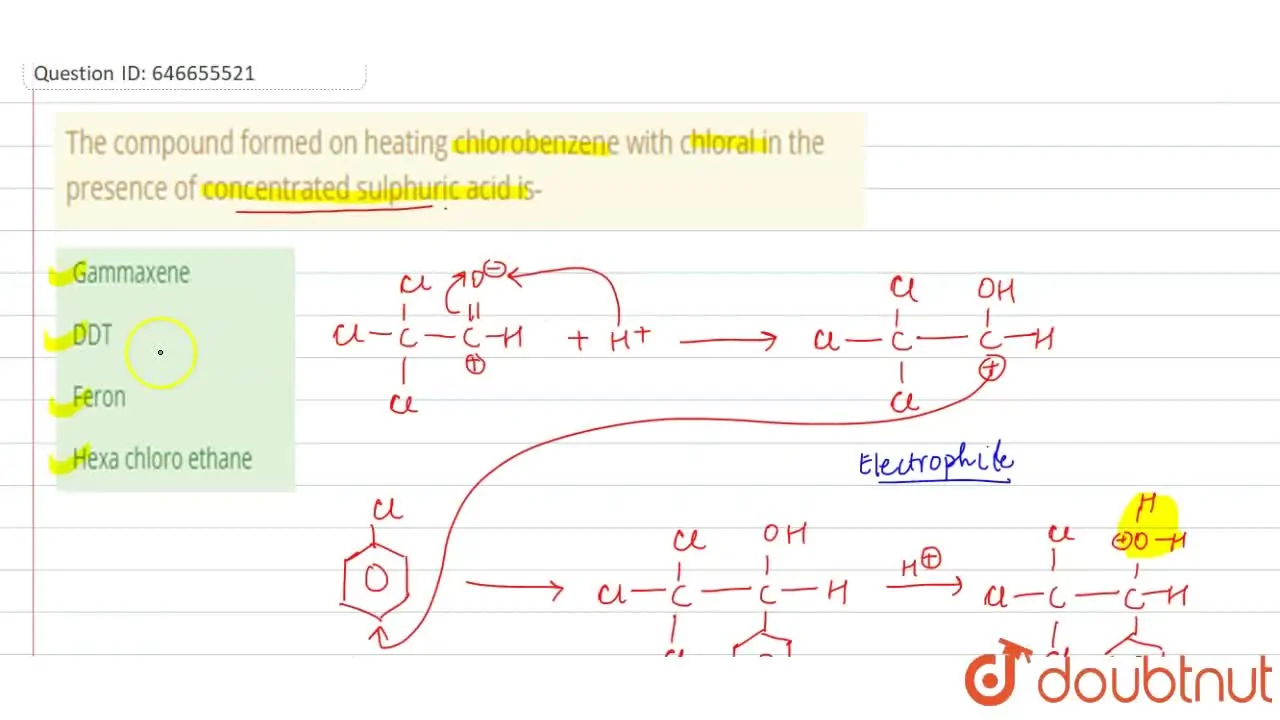The compound formed on heating chlorobenzene with chloral in the presence of concentrated sulphuric acid is-
Gammaxene
DDT
Feron
Hexa chloro ethane
The correct Answer is:B
Step by step video & image solution for The compound formed on heating chlorobenzene with chloral in the presence of concentrated sulphuric acid is- by Chemistry experts to help you in doubts & scoring excellent marks in Class 12 exams.
Related Playlists
- BOOK - ALLENCHAPTER - ALKYL AND ARYL HALIDEEXERCISE - EXERCISE-021videos
ALKYL AND ARYL HALIDE
- BOOK - ALLENCHAPTER - ALKYL AND ARYL HALIDEEXERCISE - EXERCISE-04 [A]1videos
ALKYL AND ARYL HALIDE
- BOOK - ALLENCHAPTER - ALKYL AND ARYL HALIDEEXERCISE - EXERCISE-011videos
ALKYL AND ARYL HALIDE
- BOOK - ALLENCHAPTER - ALKENE, ALKANE & ALKYNE EXERCISE - EXCERSISE-328videos
ALKENE, ALKANE & ALKYNE
- BOOK - ALLENCHAPTER - Atomic StructureEXERCISE - All Questions62videos
Atomic Structure
Similar Questions
What is the name of the compound formed by the reaction between ethanol and ethanoic acid in the presence of concentrated sulphuric acid?
View SolutionThe treatment of benzene with isobutene in the presence of sulphuric acid gives
View SolutionDehydrating cane sugar with concentrated sulphuric acid
View SolutionThe product formed by the reaction of acetaldehyde with excess of ethanol in the presence of sulphuric acid is:
View SolutionWrite a fully balanced equation for the following case :
Acetic acid is warmed with ethanol in the presence of concentrated sulphuric acid.View SolutionWrite balanced chemical equations for the Heating of ethanol at 170∘C in the presence of concentrated sulphuric acid.
View SolutionWhat is observed in addition of ethyl alcohol to acetic acid in the presence of concentrated sulphuric acid ?
View SolutionWrite balanced chemical equations for the following reactions :
Heating ethanol at 443 K (130∘C) in the presence of concentrated sulphuric acid.View SolutionThe reaction between ethanol and ethanoic acid in the presence of concentrated sulphuric acid is called ______(esterification/neutralisation)
View SolutionThe insecticide DDT (C14H9Cl)5 is prepared by heating chlorobenzene with chloral (CCl3CHO) in the presence of conc. H2SO4. Which of following compounds is DDT ?
View Solution


